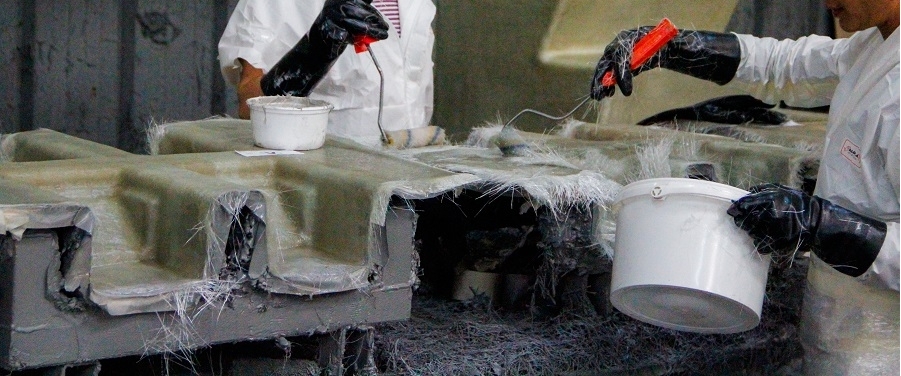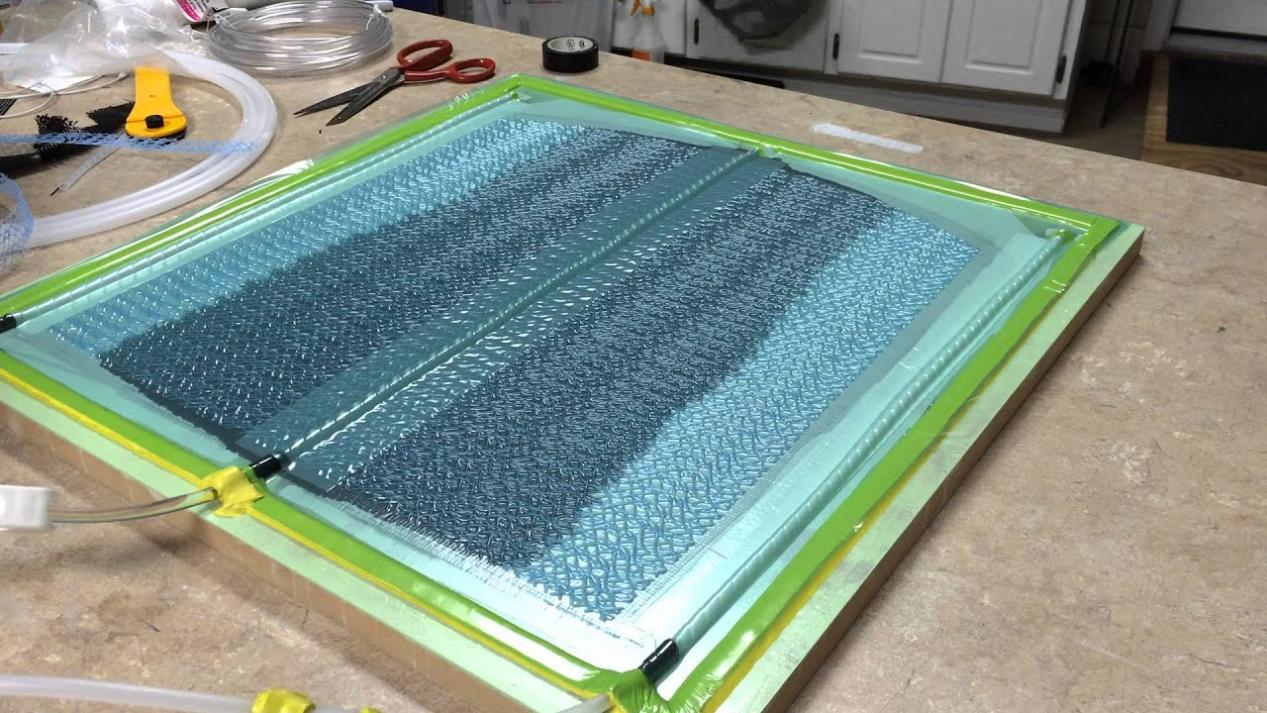The advantages and disadvantages of the two are compared as follows:
Hand lay-up is an open-mold process that currently accounts for 65% of glass fiber reinforced polyester composites. Its advantages are that it has a great degree of freedom in changing the shape of the mold, the mold price is low, the adaptability is strong, the product performance is recognized by the market, and the investment is low. So it is especially suitable for small companies, but also for the marine and aerospace industries, where it is usually a one-off large part. However, there are also a series of problems in this process. If the volatile organic compound (VOC) emission exceeds the standard, it has a great impact on the health of operators, it is easy to lose personnel, there are many restrictions on allowable materials, the product performance is low, and the resin is wasted and used in a large amount, especially the product. The quality is unstable. The proportion of glass fiber and resin, the thickness of parts, the production rate of the layer, and the uniformity of the layer are all affected by the operator, and the operator is required to have better technology, experience and quality. The resin content of hand lay-up products is generally around 50%-70%. The VOC emission of the mold opening process exceeds 500PPm, and the volatilization of styrene is as high as 35%-45% of the used amount. The regulations of various countries are 50-100PPm. At present, most foreign countries use cyclopentadiene (DCPD) or other low styrene release resins, but there is no good substitute for styrene as a monomer.
Fiberglass mat hand lay-up process
The vacuum resin introduction process is a low-cost manufacturing process developed in the past 20 years, especially suitable for the manufacture of large-scale products. Its advantages are as follows:
(1) The product has excellent performance and high yield. In the case of the same fiberglass raw materials, the strength, stiffness and other physical properties of vacuum resin-introduced components can be improved by more than 30%-50% compared with hand lay-up components (Table 1). After the process is stabilized, the yield can be close to 100%.
Table 1 Performance comparison of typical polyester fiberglass
|
Reinforcing material |
Twistless roving |
Biaxial fabric |
Twistless roving |
Biaxial fabric |
|
Molding |
Hand lay-up |
Hand lay-up |
Vacuum Resin Diffusion |
Vacuum Resin Diffusion |
|
Glass fiber content |
45 |
50 |
60 |
65 |
|
Tensile Strength(MPa) |
273.2 |
389 |
383.5 |
480 |
|
Tensile modulus(GPa) |
13.5 |
18.5 |
17.9 |
21.9 |
|
Compressive strength(MPa) |
200.4 |
247 |
215.2 |
258 |
|
Compression modulus(GPa) |
13.4 |
21.3 |
15.6 |
23.6 |
|
Bending strength(MPa) |
230.3 |
321 |
325.7 |
385 |
|
Flexural modulus(GPa) |
13.4 |
17 |
16.1 |
18.5 |
|
Interlaminar shear strength(MPa) |
20 |
30.7 |
35 |
37.8 |
|
Longitudinal and transverse shear strength(MPa) |
48.88 |
52.17 |
|
|
|
Longitudinal and transverse shear modulus(GPa) |
1.62 |
1.84 |
|
|
(2) The product quality is stable and the repeatability is good. Product quality is less affected by operators, and there is a high degree of consistency whether it is the same component or between components. The fiber content of the product has been put into the mold according to the specified amount before the resin is injected, and the components have a relatively constant resin ratio, generally 30%-45%, so the uniformity and repeatability of the product performance are better than the hand lay-up process products. more, and fewer defects.
(3) The anti-fatigue performance is improved, which can reduce the weight of the structure. Due to the high fiber content, low porosity and high product performance, especially the improvement of interlaminar strength, the fatigue resistance of the product is greatly improved. In the case of the same strength or stiffness requirements, the products made by the vacuum induction process can reduce the weight of the structure.
(4) Environment friendly. The vacuum resin infusion process is a closed mold process where volatile organics and toxic air pollutants are confined to the vacuum bag. Only trace amounts of volatiles are present when the vacuum pump is vented (filterable) and the resin barrel is opened. VOC emissions do not exceed the standard of 5PPm. This also greatly improves the working environment for operators, stabilizes the workforce, and expands the range of materials available.
(5) The product integrity is good. The vacuum resin introduction process can form reinforcing ribs, sandwich structures and other inserts at the same time, which improves the integrity of the product, so large-scale products such as fan hoods, ship hulls and superstructures can be manufactured.
(6) Reduce the use of raw materials and labor. In the same layup, the amount of resin is reduced by 30%. Less waste, resin loss rate is less than 5%. High labor productivity, more than 50% labor saving compared with hand lay-up process. Especially in the molding of large and complex geometries of sandwich and reinforced structural parts, the material and labor savings are even more considerable. For example, in the manufacture of vertical rudders in the aviation industry, the cost of reducing fasteners by 365 is reduced by 75% compared with the traditional method, the weight of the product remains unchanged, and the performance is better.
(7) The product precision is good. The dimensional accuracy (thickness) of vacuum resin introduction process products is better than that of hand lay-up products. Under the same layup, the thickness of general vacuum resin diffusion technology products is 2/3 of that of hand lay-up products. The product thickness deviation is about ±10%, while the hand lay-up process is generally ±20%. The flatness of the product surface is better than that of hand lay-up products. The inner wall of the hood product of the vacuum resin introduction process is smooth, and the surface naturally forms a resin-rich layer, which does not require additional top coat. Reduced labor and materials for sanding and painting processes.
Of course, the current vacuum resin introduction process also has certain shortcomings:
(1) The preparation process takes a long time and is more complicated. Proper layup, placement of diversion media, diversion tubes, effective vacuum sealing, etc. are required. Therefore, for small-sized products, the process time is longer than the hand lay-up process.
(2) The production cost is higher and more waste is generated. Auxiliary materials such as vacuum bag film, diversion medium, release cloth and diversion tube are all disposable, and a lot of them are currently imported, so the production cost is higher than the hand lay-up process. But the bigger the product, the smaller the difference. With the localization of auxiliary materials, this cost difference is getting smaller and smaller. The current research on auxiliary materials that can be used multiple times is a development direction of this process.
(3) Process manufacturing has certain risks. Especially for large and complex structural products, once the resin infusion fails, the product is easy to be scrapped.
Therefore, better preliminary research, strict process control and effective remedial measures are required to ensure the success of the process.
Our company products:
Fiberglass roving, fiberglass woven roving, fiberglass mats, fiberglass mesh cloth, unsaturated polyester resin, vinyl ester resin, epoxy resin, gel coat resin, auxiliary for FRP, carbon fiber and other raw materials for FRP.
Contact Us
Phone number:+8615823184699
Email: marketing@frp-cqdj.com
Website: www.frp-cqdj.com
Post time: Oct-20-2022









